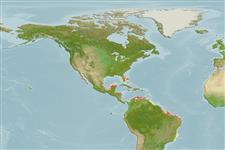Common names from other countries
Classification / Names / Names
Populärnamn | synonymer | Catalog of Fishes (gen., sp.) | ITIS | CoL | WoRMS
Environment: milieu / climate zone / depth range / distribution range
Ekologi
; brackvatten. Tropical
Western Central Atlantic: Belize, Panama, and Venezuela.
Length at first maturity / Size / Vikt / Age
Maturity: Lm ? range ? - ? cm Max length : 0.6 cm OT hane/ej könsbestämd; (Ref. 415)
This-encrusting: 0.3 - 0.6 cm thickness. Lemon yellow to orange. Numerous pronounced dermal channels converge towards collared-transparent oscula: 0.1 - 0.3 cm wide. Very soft and fragile, releases copias amounts of mucus upon handling (Ref. 415).
Maximum thickness: 0.6 cm (Ref. 415). Common on mangrove overhangs and peat banks protected from direct sunlight (Ref. 415).
Life cycle and mating behavior
Könsmognad | Reproduktion | Lek | Ägg | Fecundity | Larver
Members of the class Demospongiae are hermaphroditic. Life cycle: The zygote develops into parenchymella larva (free-swimming) before settling down on a substrate where it grows into a young sponge.
Collin, R., M.C. Díaz, J. Norenburg, R.M. Rocha, J.A. Sánchez, M. Schulze, A. Schwartz and A. Valdés. 2005. (Ref. 415)
IUCN Red List Status (Ref. 130435)
CITES status (Ref. 108899)
Not Evaluated
Not Evaluated
Threat to humans
Harmless
Human uses
| FishSource |
Verktyg
Ytterligare information
Age/SizeTillväxtLength-weightLength-lengthMorfologiLarverAbundans
Internet-källor
Estimates based on models
Vulnerability
Low vulnerability (10 of 100).
Price category
Unknown.
